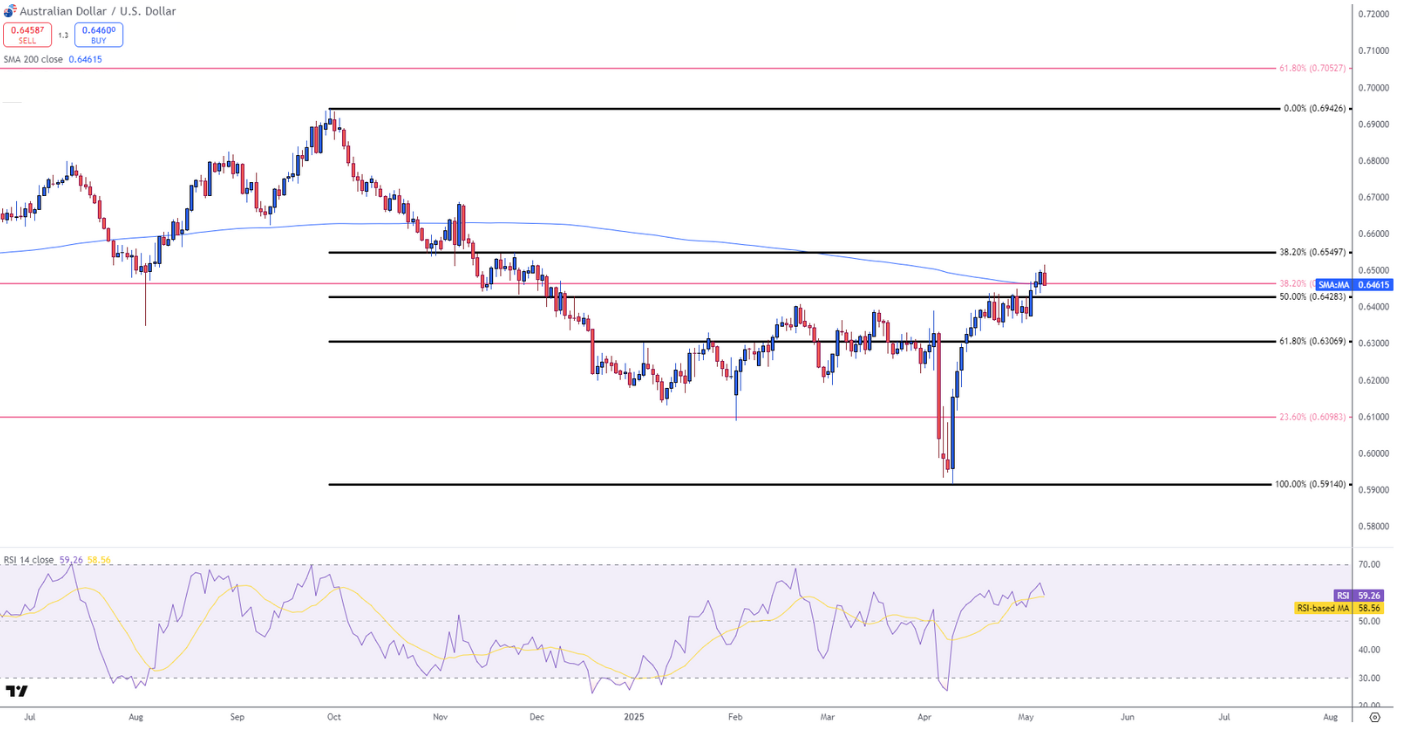Created
: 2025.05.08














![]() 2025.05.08 01:19
2025.05.08 01:19
The Australian Dollar (AUD) is trading lower on Wednesday after failing to break above a key resistance level, with markets turning cautious ahead of expected commentary from United States (US) Federal Reserve (Fed) Chair Jerome Powell and high-level trade talks between the US and China.
At the time of writing, the AUD/USD pair is trading at 0.6467, pulling back from the five-month high of 0.6515, just below the December 2024 peak of 0.65156.
This mild retreat reflects consolidation rather than reversal, as traders await clarity on monetary policy, global risk sentiment, and the near-term demand outlook tied to China.
The next directional move in AUD/USD will likely hinge on three critical themes: the Federal Reserve's policy guidance, the tone and outcome of the upcoming US-China talks, and China's latest round of economic stimulus.
With the Federal Reserve meeting scheduled for Wednesday at 18:00 GMT, markets expect interest rates to remain unchanged.
The focus is not on immediate action but on when monetary easing will begin, with a 25 basis point cut currently priced in for July. Traders are particularly interested in whether comments from Chair Jerome Powell alter the current outlook or reinforce expectations for a mid-year pivot.
While policy rates are likely to stay on hold, any shift in tone could have significant implications for the US Dollar (USD). A dovish message would support the case for July easing and could benefit risk-sensitive currencies like the Australian Dollar. Conversely, a more cautious or data-dependent stance could strengthen the US Dollar and pressure AUD/USD lower.
Although monetary policy dominates near-term positioning, geopolitics is also in play.
On Tuesday, US Secretary of the Treasury Scott Bessent stated that trade talks between senior US and Chinese officials are expected to begin on Friday in Switzerland. While formal confirmation remains pending, markets are sensitive to any signal of progress or breakdown.
For the Australian Dollar, the stakes are high. As a major exporter of iron ore, coal, and other commodities to China, Australia's economic outlook is tightly linked to Chinese demand. Any easing of trade tensions between Washington and Beijing could lift expectations for Chinese growth and indirectly support the AUD. Conversely, if talks stall or rhetoric hardens, risk appetite may fade, capping further upside in the pair.
Meanwhile, Australia's political and economic backdrop remains steady. On Saturday, the federal election delivered a clear victory for Prime Minister Anthony Albanese's Labor Party, removing political uncertainty and reinforcing expectations for policy continuity. While the result has had little direct impact on currency markets, it supports a stable investment climate.
Economically, inflation in Australia remains above the Reserve Bank of Australia's (RBA) target range but is gradually easing. The labour market is still tight, though recent data suggests moderation in hiring momentum. The RBA is expected to hold rates steady in the near term while monitoring inflation and wage growth. Domestically, these conditions are broadly neutral for the AUD, leaving external drivers -- particularly the Federal Reserve and China -- as the key influencers.
China's macroeconomic policy also continues to shape expectations for the Australian Dollar. On Wednesday, Chinese authorities cut the benchmark interest rate by 10 basis points to 1.4% and lowered the Reserve Requirement Ratio by 50 basis points, injecting approximately 1 trillion yuan (USD 138 billion) into the banking system. The measures aim to stabilise domestic demand and support growth amid ongoing headwinds.
For Australia, stronger Chinese demand typically boosts exports and commodity prices, lending indirect support to the AUD. While the immediate market reaction was measured, investors will now look for confirmation through data, particularly in trade, manufacturing, and credit, to determine whether the stimulus is gaining traction.
From a technical perspective, AUD/USD remains within a bullish structure but has failed to clear a major resistance zone near 0.6515, a level aligned with the December high at 0.65156.
The pair has since pulled back modestly and is now consolidating just below the 200-day Simple Moving Average (SMA), which currently sits at 0.6461 and continues to act as dynamic resistance.
Momentum indicators remain constructive, with the Relative Strength Index (RSI) on the daily chart at 60.12, above the neutral 50 level, suggesting that buyers have not exited, but conviction has weakened in the absence of a new catalyst.
Two major Fibonacci retracement levels help frame near-term trading conditions. The short-term retracement, drawn from the September 2024 high of 0.6943 to the April low of 0.5868, places the 38.2% level at 0.6549 -- now acting as initial upside resistance -- while the 50.0% and 61.8% levels come in at 0.6428 and 0.6307, respectively, providing layered support.
On a broader scale, the long-term Fibonacci retracement, taken from the March 2020 low of 0.5507 to the February 2021 high of 0.8007, places the 23.6% retracement at 0.6699 and the 50.0% level at 0.6758 -- targets that would only come into view on a decisive breakout beyond the current range.
AUD/USD daily chart

A daily close above the 0.6515-0.65156 resistance area would confirm a breakout and could open the path toward 0.6549, corresponding to the 38.2% retracement of the September-April decline. A stronger rally could then extend toward 0.6699 and 0.6758, both part of the long-term retracement range. A dovish message from Jerome Powell, progress in trade negotiations, or stronger-than-expected Chinese data could trigger this scenario.
Failure to hold above the 200-day SMA at 0.6461 and the 50.0% short-term retracement at 0.6428 would shift the bias lower.
In that case, support at 0.6380, a former range high, becomes vulnerable, with 0.6307 (61.8% short-term retracement) the next key level. A hawkish tilt from the Federal Reserve, trade friction, or weak Chinese indicators could accelerate downside momentum.
One of the most significant factors for the Australian Dollar (AUD) is the level of interest rates set by the Reserve Bank of Australia (RBA). Because Australia is a resource-rich country another key driver is the price of its biggest export, Iron Ore. The health of the Chinese economy, its largest trading partner, is a factor, as well as inflation in Australia, its growth rate and Trade Balance. Market sentiment - whether investors are taking on more risky assets (risk-on) or seeking safe-havens (risk-off) - is also a factor, with risk-on positive for AUD.
The Reserve Bank of Australia (RBA) influences the Australian Dollar (AUD) by setting the level of interest rates that Australian banks can lend to each other. This influences the level of interest rates in the economy as a whole. The main goal of the RBA is to maintain a stable inflation rate of 2-3% by adjusting interest rates up or down. Relatively high interest rates compared to other major central banks support the AUD, and the opposite for relatively low. The RBA can also use quantitative easing and tightening to influence credit conditions, with the former AUD-negative and the latter AUD-positive.
China is Australia's largest trading partner so the health of the Chinese economy is a major influence on the value of the Australian Dollar (AUD). When the Chinese economy is doing well it purchases more raw materials, goods and services from Australia, lifting demand for the AUD, and pushing up its value. The opposite is the case when the Chinese economy is not growing as fast as expected. Positive or negative surprises in Chinese growth data, therefore, often have a direct impact on the Australian Dollar and its pairs.
Iron Ore is Australia's largest export, accounting for $118 billion a year according to data from 2021, with China as its primary destination. The price of Iron Ore, therefore, can be a driver of the Australian Dollar. Generally, if the price of Iron Ore rises, AUD also goes up, as aggregate demand for the currency increases. The opposite is the case if the price of Iron Ore falls. Higher Iron Ore prices also tend to result in a greater likelihood of a positive Trade Balance for Australia, which is also positive of the AUD.
The Trade Balance, which is the difference between what a country earns from its exports versus what it pays for its imports, is another factor that can influence the value of the Australian Dollar. If Australia produces highly sought after exports, then its currency will gain in value purely from the surplus demand created from foreign buyers seeking to purchase its exports versus what it spends to purchase imports. Therefore, a positive net Trade Balance strengthens the AUD, with the opposite effect if the Trade Balance is negative.
![]()
Created
: 2025.05.08
![]()
Last updated
: 2025.05.08

FXStreet is a forex information website, delivering market analysis and news articles 24/7.
It features a number of articles contributed by well-known analysts, in addition to the ones by its editorial team.
Founded in 2000 by Francesc Riverola, a Spanish economist, it has grown to become a world-renowned information website.
We hope you find this article useful. Any comments or suggestions will be greatly appreciated.
We are also looking for writers with extensive experience in forex and crypto to join us.
please contact us at [email protected].
Disclaimer:
All information and content provided on this website is provided for informational purposes only and is not intended to solicit any investment. Although all efforts are made in order to ensure that the information is correct, no guarantee is provided for the accuracy of any content on this website. Any decision made shall be the responsibility of the investor and Myforex does not take any responsibility whatsoever regarding the use of any information provided herein.
The content provided on this website belongs to Myforex and, where stated, the relevant licensors. All rights are reserved by Myforex and the relevant licensors, and no content of this website, whether in full or in part, shall be copied or displayed elsewhere without the explicit written permission of the relevant copyright holder. If you wish to use any part of the content provided on this website, please ensure that you contact Myforex.
Myforex uses cookies to improve the convenience and functionality of this website. This website may include cookies not only by us but also by third parties (advertisers, log analysts, etc.) for the purpose of tracking the activities of users. Cookie policy